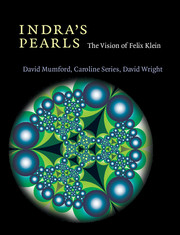Book contents
- Frontmatter
- Contents
- Preface
- Introduction
- 1 The language of symmetry
- 2 A delightful fiction
- 3 Double spirals and Möbius maps
- 4 The Schottky dance pages 96 to 107
- 4 The Schottky dance pages 107 to 120
- 5 Fractal dust and infinite words
- 6 Indra's necklace
- 7 The glowing gasket
- 8 Playing with parameters pages 224 to 244
- 8 Playing with parameters pages 245 to 267
- 9 Accidents will happen pages 268 to 291
- 9 Accidents will happen pages 291 to 296
- 9 Accidents will happen pages 296 to 309
- 10 Between the cracks pages 310 to 320
- 10 Between the cracks pages 320 to 330
- 10 Between the cracks pages 331 to 340
- 10 Between the cracks pages 340 to 345
- 10 Between the cracks pages 345 to 352
- 11 Crossing boundaries pages 353 to 365
- 11 Crossing boundaries 365 to 372
- 12 Epilogue
- Index
- Road map
9 - Accidents will happen pages 291 to 296
Published online by Cambridge University Press: 05 January 2014
- Frontmatter
- Contents
- Preface
- Introduction
- 1 The language of symmetry
- 2 A delightful fiction
- 3 Double spirals and Möbius maps
- 4 The Schottky dance pages 96 to 107
- 4 The Schottky dance pages 107 to 120
- 5 Fractal dust and infinite words
- 6 Indra's necklace
- 7 The glowing gasket
- 8 Playing with parameters pages 224 to 244
- 8 Playing with parameters pages 245 to 267
- 9 Accidents will happen pages 268 to 291
- 9 Accidents will happen pages 291 to 296
- 9 Accidents will happen pages 296 to 309
- 10 Between the cracks pages 310 to 320
- 10 Between the cracks pages 320 to 330
- 10 Between the cracks pages 331 to 340
- 10 Between the cracks pages 340 to 345
- 10 Between the cracks pages 345 to 352
- 11 Crossing boundaries pages 353 to 365
- 11 Crossing boundaries 365 to 372
- 12 Epilogue
- Index
- Road map
Summary
Heading for the boundary
In Chapter 8, we played (rather irresponsibly) with traces around 2. One especially spiralliferous spot was near trace 1.91+0.05i, exactly the complex conjugate of the trace corresponding to the μ-value 0.05+1.91i, the red dot in Figure 9.12. (Complex conjugate traces, remember, give mirror image groups.) Looking back at Figure 8.17, perhaps you can see how we might have predicted that the μ-value for this group should be near the 1/9 and 1/10 cusps. The spiral head is largest around words with prefix ab10 and ab9, and in fact the most extreme point seems to be about ab9ab10. The roles of a and b are reversed because of the mirror symmetry, which more or less explains why in our present set-up it is a good idea to declare a10B a special word.
Figure 9.12 is like a road map, delineating the boundary between order and chaos. How about using it to drive right up to one of these two nearby cusps? With any luck, it should exhibit both the beautiful spirals of Figure 8.17 and the delicate lacework of the Apollonian gasket. Imagine how those two effects will be combined. The results are – wait one moment, let's not get ahead of ourselves. Perhaps we should look very closely at the boundary near μ = 0.05 + 1.91i. Zoom in to the red dot in Figure 9.12 to get the very small (0.03 × 0.03) frame in Figure 9.14.
- Type
- Chapter
- Information
- Indra's PearlsThe Vision of Felix Klein, pp. 291 - 296Publisher: Cambridge University PressPrint publication year: 2002

